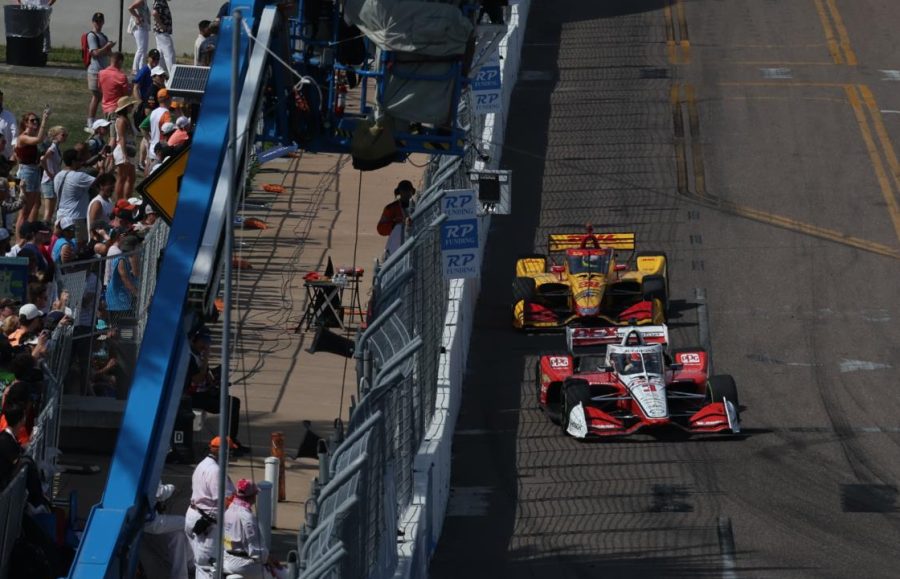IndyCar racing needs a tune-up
Romain Grosjean and Scott McLaughlin racing at the IndyCar season opener
April 23, 2023
How can IndyCar be fixed?
The short answer is the cars don’t need changing but how IndyCar is covered by media needs to change. Now don’t turn the page or scroll to the next article on Twitter because there’s a lot more to IndyCar’s dilemma with how the sport is covered.
One of the things that could help IndyCar gain more attention is to have more races on the schedule. IndyCar has the fewest races between the big three racing series in the world — NASCAR has 36 races a year, F1 has 23, and IndyCar has only 17 races each season.
IndyCar doesn’t need to go overboard, expand the schedule to 36 races like NASCAR and be racing year around. IndyCar needs three or four more races to make the championship exciting.
By the time the Indy 500 rolls around, IndyCar is already five races into the 17-race season. If someone is a casual fan of IndyCar, doesn’t watch every race but they tune into the Indy 500 only to find out that IndyCar is almost halfway through the season, they’re going to wonder why the season is so short, which brings up another point.
IndyCar does not need one to three week breaks in between races. The 2023 IndyCar season is only two races in by the middle of April. NASCAR is eight races into their season, and F1 has had four races and they go all around the world.
IndyCar will tell their fans that the reason they take a three week break in between the first and second races is because the rookies need to pass their oval speed tests. The first race is a street course in St. Petersburg, FL, and the second race is at the Texas Motor Speedway where the cars are going 220 mph into the corner. So yes, during this three week break between St. Pete and Texas, teams are testing at tracks all over the country which is good because a race team always wants to win. But 90 percent of the fans don’t really care about testing because it does not count for points. The fans are more interested in the races because that’s how teams win championships.
IndyCar needs less time in between races and needs a couple more races each season. David Land, an IndyCar and motorsports journalist, said it best: “TV ratings…are more about the momentum when the cars are not on track, that actually gets people to tune in.”
Land recalled that recently when he was in the media bullpen he asked a couple questions about the St. Pete race but “that was four weeks ago I don’t think anybody even remembers or cares about [St. Pete].”
IndyCar doesn’t have an on-track race problem. IndyCar’s problem is that there is hardly any hype or coverage leading up to the races outside of the Indy 500. IndyCar has the same problem once the races have ended — there is hardly any coverage.
For example, the first race at St. Petersburg was an amazing race. Right from the get go there was a pile up of six cars on the first lap. After the crash had been cleared up there was another pile up on lap 42, three cars piled into the tire barriers in turn four.
Once the wreck had been cleared green flag pit stops were in full effect in the middle part of the race. The two leaders, Scott McLaughlin and Romain Grosjean were battling for the lead. When McLaughlin got out of the pits he was right with Grosjean. Grosjean was on warm tires that have grip and McLaughlin was on cold fresh tires with not much grip. McLaughlin filed out of the pits right beside Grosjean, as they approached turn four Grosjean pulled to the outside of McLaughlin. McLaughlin held his ground and made the right turn for turn four, Grosjean made the turn as well — both drivers didn’t want to give an inch. They slammed into each other, didn’t make the corner and slammed into the tire barrier in four. This all happened on lap 72 of 100.
The race wasn’t over yet with the two front runners out. The third place driver Pato O’Ward snuck through to take the lead. O’Ward led until four laps to go when he came off of turn 14 on to the front stretch, over-revved his engine and slid. Then the second place car of Marcus Ericsson snuck by and took the lead. Ericsson would go on to win the race.
St. Pete was the best season opener for IndyCar. There was so much action but did IndyCar do anything with this exciting race? Wellllll, kind of — IndyCar used the race for their commercials for the series but they didn’t hype the possible rivalry brewing between McLaughlin and Grosjean. IndyCar shared an interview with the dejected O’Ward which is good. But a lot happened in the season opener. It is hard to understand why IndyCar didn’t hype any of the action that happened at St. Pete before the next race at Texas.
Simply put, IndyCar’s biggest problem is marketing, marketing, marketing. If this article reaches the honchos at IndyCar, they need to focus more on the coverage when the cars aren’t on tracks. IndyCar, it is 2023 you need to market yourself like you’re a serious racing series. Get with the times IndyCar, your fans want to see the sport grow and be successful.

